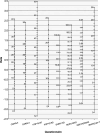A common metric for questionnaires on health anxiety in cancer patients
- PMID: 39691670
- PMCID: PMC11649417
- DOI: 10.3389/fpsyg.2024.1455121
A common metric for questionnaires on health anxiety in cancer patients
Abstract
After a cancer diagnosis, life is accompanied by worries, concerns and fears that the disease will recur or worsen. These can be normal and useful reactions but may also become so severe that they interfere with everyday functioning. A challenge for patient care is that the theoretical similarity of these reactions, is not consistently conceptualized in practice, hence the empirical comparability of their measures is unclear. Here we intend to show that the theoretical similarity is also empirically justified, and we present a common metric in graphical form that allows direct comparisons between different questionnaires. A total of 1,733 cancer patients completed the Fear of Progression Questionnaire Short Form, Questionnaire on Stress in Cancer Patients-revised version, Concerns About Recurrence Questionnaire, the subscales Health Distress and Negative Health Outlook of the EORTC QLQ-SURV100, and the Whiteley Index. Using a model based on item response theory, we linked the score values of the individual questionnaires. The main outcome of this study is a diagram that can be used to convert the respective values of eight questionnaires on health anxiety to another. All instruments showed a reliability above 0.75 near the mean health anxiety level. The common metric can be used to compare measurements with these questionnaires in terms of the level of health anxiety. Additionally, the reliability of the instruments can be judged at different levels of anxiety. This allows for a better comparability of test results and facilitates communication about the results among experts and with patients.
Keywords: cancer; common metric; conversion; fear; health anxiety; progression; recurrence; worry.
Copyright © 2024 Friedrich, Schulte, Malburg and Hinz.
Conflict of interest statement
The authors declare that the research was conducted in the absence of any commercial or financial relationships that could be construed as a potential conflict of interest.
Figures


References
-
- Carstensen T. B. W., Ørnbøl E., Fink P., Pedersen M. M., Jørgensen T., Dantoft T. M., et al. . (2020). Detection of illness worry in the general population. A specific item on illness rumination improves the Whiteley index. J. Psychosom. Res. 138:110245. doi: 10.1016/j.jpsychores.2020.110245, PMID: - DOI - PubMed
LinkOut - more resources
Full Text Sources

